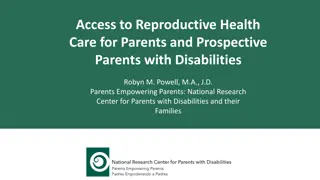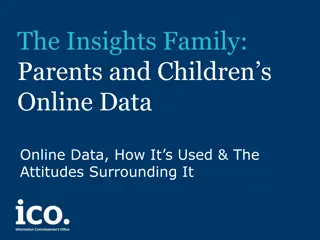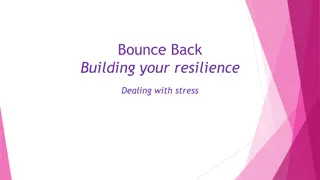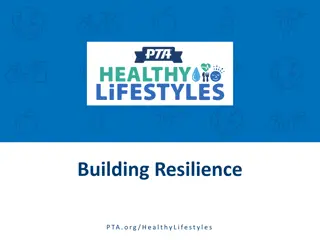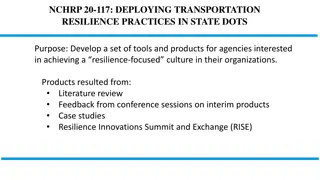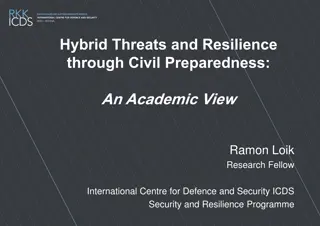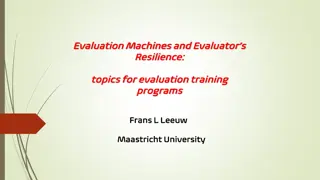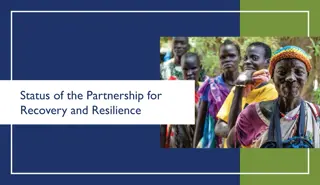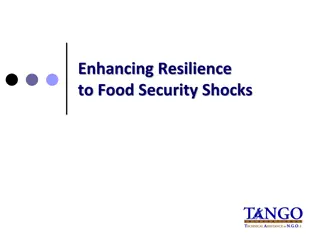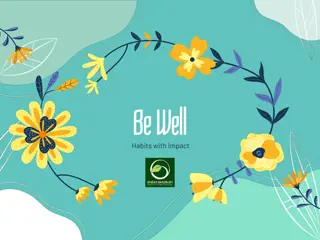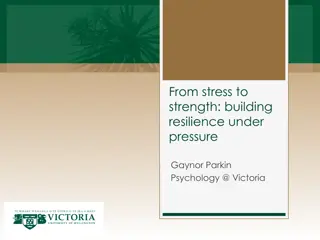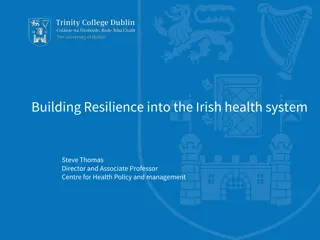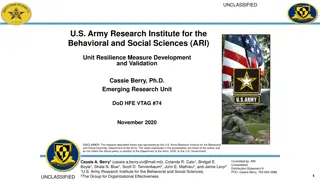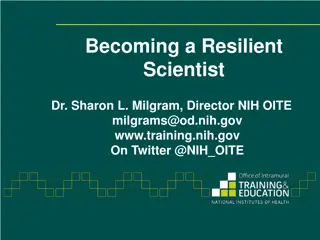Building Resilience in Anxious Kids and Parents
In a world full of uncertainty and bumps, embracing discomfort and stepping into the unknown can help build resilience. Learn how children of anxious parents are more likely to experience anxiety and how to break this cycle. Discover strategies to handle distress, manage uncertainty, and promote disruptive change for improved performance and well-being.
Download Presentation

Please find below an Image/Link to download the presentation.
The content on the website is provided AS IS for your information and personal use only. It may not be sold, licensed, or shared on other websites without obtaining consent from the author.If you encounter any issues during the download, it is possible that the publisher has removed the file from their server.
You are allowed to download the files provided on this website for personal or commercial use, subject to the condition that they are used lawfully. All files are the property of their respective owners.
The content on the website is provided AS IS for your information and personal use only. It may not be sold, licensed, or shared on other websites without obtaining consent from the author.
E N D
Presentation Transcript
WORRY .. ?? Sue Mills MSW, BSW, RSW Child and Youth Counselor Sun West School Division Equine Facilitated Wellness Professional Based on the Book Anxious Kids, Anxious Parents by: Dr. Reid Wilson, PhD and Lynn Lyons, LICSW (Sept. 3, 2013)
As humans we are continually in search of the quickest, easiest, most convenient and least uncomfortable path to any given end. The trouble with our smooth, well-ironed environment is that the REAL world has bumps life has bumps. We can continue to detour around every approaching pothole, or we can accept and embrace the uncertainty that comes with daily life. By doing so we train our brains to deal with ever- changing circumstances and unexpected life events. When you work with trainers or fitness coaches, they do not put you on the elliptical machine on a steady incline at a constant pace. They put you on the exercise ball and do their best to make you a little unstable. Why? To promote disruptive change. That s how you build strength, build muscles, increase stamina, and improve balance and performance.
To build resilience, we need to learn to handle distress and rebound after an incident. By doing that, we will improve our performance. We need to get out of balance, out of our set routine, and out of our comfort zone. We must seek opportunities to feel clumsy, awkward, embarrassed, insecure, and self-conscious. If we re truly interested in living in the real world the world of cracks and crevices, the world of instability and accidents and unexpected incidents then we must train ourselves to cope with the insecurity of not knowing and the sensations that come with awkwardness. That leads to resilience our ability to spring back from troubled times. We must learn to deal with variability in our environment, unpredictability in our lives, and changes in the nature of our circumstances. We must, first and foremost, learn to step on the cracks rather than stepping around, over, or between them. Dr. Reid Wilson
PREVALENCE Anxiety is #1 mental health problem in USA and CANADA 1 in 5 kids have some form of anxiety (not necessarily diagnosed) It is the most frequent reason parents bring children to a mental health provider Children of parents with an anxiety disorder are 6 to 7 times more likely to have anxiety disorder.
Children of anxious parents are more likely to - perceive uncertain situations as more threatening - have lower estimates of their competency to cope with uncertain situations - engage in all-or-nothing thinking (perfectionistic) - become masters of negative expectancy - have more somatic complaints are fearful of their physical/somatic symptoms -
Anxiety has figured out how to be overwhelming On the other hand, anxiety is not that complex Anxiety Demands TWO Things: Certainty: I have to know what s going to happen next and I want to control it! Comfort: I want to feel safe and comfortable or else I want out!
Fight, Flight, or Freeze Trigger Event Trigger Event! Intensified Physical Reaction Worried Thought Worried Thoughts! Amygdala Activated! Physical Response! More Worried Thoughts! Intensified Physical Reactions More worried thoughts Amygdala activated Physical Response
WILD animals dont get anxiety. (domestic animals can because humans thwart their ability to respond naturally) In response to a threat, the wild animal can fight, flee, or freeze. These responses exist as parts of a natural defense system. If an organism is unable to execute the fight, flight or freeze response energy is amplified and bound up in the nervous system. (Levine, 1997). In this emotional and anxious state, the now-frustrated fight response may erupt into rage and the frustrated flight response gives way to helplessness. The real dilemma is why humans don t do what animals do when they have survived; shake, sweat, and breathe it all out. (Scaer, 2005). We need to teach kids how to survive anxiety not avoid it.
Instead of resisting worry, lets give it respect & appreciation Kids don t need to stop being scared They need to take action while they are scared When you avoid .. anxiety gets stronger. If a person goes towards fear and is able to handle it anxiety gets weaker. During treatment, anxiety will probably get stronger before it gets weaker. You can tolerate anxiety. Anxiety will not physically harm you.
Be Proactive instead of Reactive Do the opposite of what anxiety wants you to do Example: I don t want to go to kindergarten (or Grade __ ) and be in the classroom because the kids scare me or they are mean to me. - What do the parents do? They pull their child out of school. Result Mom and Dad have just proved to me that school is a scary place and they need to be at school with me, or keep me home to protect me. They have also shown me that I can t handle this situation .I need someone else to handle it for me.
Adults Start by saying, You re right to be scared, instead of, You re wrong to be scared. Adult should say, Of course you are scared. You re not sure if you re going to be able to handle [that upcoming event.] It s perfectly natural to have worries in that situation.
Steps to Help Kids Overcome Anxiety
1. Expect to Worry Stop acting startled by each new occurrence of worry and expect worry to appear in certain situations. It is okay to worry! Figure out when to ignore those normal, expected worried thoughts andwhen to pay attention to them.
2. Talk to Your Worry If you can expect it, then you can talk to it. You usually show up at these times, so I am not surprised you are here. Take Care of it I am safe, even though I feel scared Boss it around Your not helping, I am going to ignore you
3. Be Unsure & Uncomfortable on Purpose Worry says STOP. Worry is not a big fan of moving forward. Worry fires off your alarm system, usually way too much Anxious kids & their parents, try to stay comfortable & try to control things so that there will be no anxiety occurring which is attached to an event, circumstance or situation. The problem is ..we cannot control EVERYTHING !
The Critical Attitude Shift If I m uncomfortable or unsure or nervous . I m learning something new . I m on the right track
Shifting Attitudes We are NOT eliminating or avoiding physical symptoms. We are perceiving & managing them through a different lens. If you will stop telling your alarm center that there s danger, it will learn on its own not to push that danger button. These are messages to try out I m willing to feel uncomfortable I m willing to feel unsure & to not know what will happen I m willing to grab onto my courage & do it Reassurance and anxiety: short term decrease, long term increase
Step into Unknown Territory Stop saying, I ve GOT to know that everything will turn out just right Start saying, I m WILLING to NOT KNOW how things are going to turn out Stop saying, I ve got to feel comfortable Start saying, I m WILLING to feel UNCOMFORTABLE
10 10 10 - Will what I am worried about matter in: 10 minutes 10 hours 10 days
4. Breathe Simple, brief relaxation skills to manage discomfort as brain relearns. Example: GoNoodle, progressive relaxation, body scan, guided meditations, yoga Parents & Teachers get to MODEL staying calm when their child/student escalates through breathing in front of them. Experiment with new activities until you find one that fits, adding variety also helps. Integrate DAILY.. 10 minutes of breathing time dedicated to regulating body sensations. This creates mastery of the skill of breathing/calming so that it can easily be used when needed in a anxious moment.
5. Know What You Want Reaching a goal requires finding a WANT-TO & then figuring out steps that will get you there. ASK: What do I want? 1. What am I doing to get what I want? 2. Is it working? 3. If it is not working, what do I need to do differently? 4.
How to get what you want. - Deliberately choose to do what s hard & uncomfortable. - Worry must show up if you are to learn a new way to manage worry. - Trying new things is a good way to get worry to show up. - Pick goals that you really do want to accomplish because then you will feel more motivated to face your worries
6. Bridge Back to Your Successes Anxious children suffer from amnesia . When they are in a state of anxiousness they are not thinking with their Cognitive Brain, they are reacting with their Emotional and Instinctual Brain (Fight, Flight or Freeze)
Help kids learn from new experiences & create a pattern of remembering by reminding them of their past successes: 1. What can you do now (automatically) that you couldn t do a few years ago? 2. Can you remember something that was really challenging when you first tried it but now seems simple? 3. Make a list of accomplishments that make you proud. Learned to ride a bike? Mastered your times tables? Went to camp (and had fun!)?
Building Reminder Bridges A month ago I bought a new pair of hiking boots. My old boots lasted a decade, and I loved them. But they fell apart this fall, and I said a sad goodbye. Having comfortable boots is a big deal for hikers, so I was nervous about the purchase. My new boots felt good when I wore them in the store, but the first time out, the arch felt a bit high and intrusive. I focused on this sensation as I hiked. I talked about it to my husband. I began to panic a bit inside. Then, miraculously, my foot somehow adjusted. It eased into the arch of the boot, and I relaxed into my purchase. This past weekend, I put the boots on again to take a walk in the woods. And the arch in the right foot felt uncomfortably high. I walked around the house, testing them out. I expressed my concern to my husband, who commented that the conversation sounded very familiar. I left for my walk, concerned about the fit, maybe even a bit obsessed. And about two miles in, my foot made peace with the arch in the boot. It felt great. Again. Just like the last time, my husband said when I came home and happily reported the outcome. I am toying with the idea of putting a note to myself in my boot, reminding me of this process. I think I ll remember they fit well, but I m not convinced. Why? Because worry makes you forget.
7. Take Action on Your Plan Have a written, step-by-step plan for the child to handle a certain worry. The emphasis is on the child s ability to solve their problem. Example: Do a speech in front of the class. Talk in front of the class. Talk in front of a few friends Talk in front of my friend Talk in front of mom and dad Talk in front of my mom Talk in front of a mirror
Review Steps to Help Kids Overcome Anxiety Expect worry to show up 1. Talk to your worries so they can t ruin/run the show 2. Be willing to feel unsure and uncomfortable along the way 3. Let your breathing skills support you 4. Know what you want to accomplish 5. Remember past successes that can help you 6.
Parenting Patterns that Make Sense & DON T WORK Reassuring, rescuing & overprotecting Providing certainty in their child s world Identifying their child as a worrier because it runs in the family, overplaying the genetic card Allowing bad behavior (yelling, swearing, tantrums, hitting) because it s part of anxiety Modeling anxiety with their own anxious behavior Pushing too hard, becoming angry & explosive, punishing
The NON-Anxious Parent Is often disregarded by the anxious parent because they don t know what it is like. However, they are an important role model for the anxious child. This parent will need coaching & validation to become involved in the child s anxiety issues. However, this is often hard because the anxious parent will often over take their efforts. If we can get parents to shift from overprotecting . to promoting competency . We will see a decrease in childhood anxiety.
Avoidance Strengthens anxiety Overprotective, Indulgent Parents Adults (with anxiety) often have a difficult time with ignoring anxiety. They don t want their child to feel what they feel, and so they teach avoidance to their child. What should adults do instead ? Model calm postures and calm breathing ( fearful facial expressions & body language reinforce anxiety) 1.
Accommodation Limits your range of what you are able to do Making accommodations (allowing avoidance) does not allow teaching or skill building to take place What should adults do instead ? Do not adjust family routines or schedules 1. Do not allow unacceptable behavior & refer to it as anxiety 2. If medication is used, it must be in conjunction with therapy and skill building. 3.
Reassurance A child will not feel more secure just because you are telling them they should. They are not believing it within themselves. Example: You will be safe in a fire. What should adults do instead ? 1. Help the child come up with their own PLAN on how they could handle the situation.
Example of making Avoidances /Accommodations / and Reassurances Child does not want to sleep alone. So the parent: Listens to all of the reasons why the child does not want to sleep alone. (Parent gets into the details of a situation instead of just thinking of it as anxiety talking). 1. Parent then tries to reassure the child that they will be fine; there are no monsters under the bed, the boogie man does not exist, a burglar will not come in the window, mom and dad are right outside the room. 2. The child does not buy it and screams and cries and puts up a fuss. (Unacceptable behavior is accommodated because child is protesting and that is uncomfortable for child and parent). 3. Parent then lies down with the child and sleeps with the child. (family routine is adjusted in an effort to reduce anxiety and the child is allowed to avoid sleeping by themselves.) 4.
Building Emotional Independence Encourage children to think independently Ask What could they do to make the situation better? 1. Ask for the child s opinion How do they think things will turn out? 2. Acknowledge & demonstrate respect for a child s view I understand that you are scared I might be scared in that situation too. 3. Teach them how to talk themselves through fears, not talk themselves out of fears or situations that may cause them fears. 4. Don t remove the hurdle, teach them to jump over it 5.
Emotional Independence cont 6. Tolerate differences of opinion & feelings (esp. anger & sadness) 7. Focus on problem-solving (they do the work) & negotiation of conflict 8. Learning the skill of arguing/disagreeing respectfully and then successfully managing conflict within family and school environments will result in better handling peer pressure & decision making 9. Let children think for themselves and make their own mistakes by doing this they will gain confidence in their ability to handle anxiety. 10. They will develop an .. I can handle this attitude !
Resources Many workbooks on anxiety for a variety of ages www.lynnlyonsnh.com www.anxietybc.com www.teenmentalhealth.org When Something is Wrong: Strategies for Teachers (Teen Mental Health) Supporting Minds: An Educators Guide to Promoting Student Mental Health and Well Being. (http://www.edu.gov.on.ca/eng/document/reports/health.html)
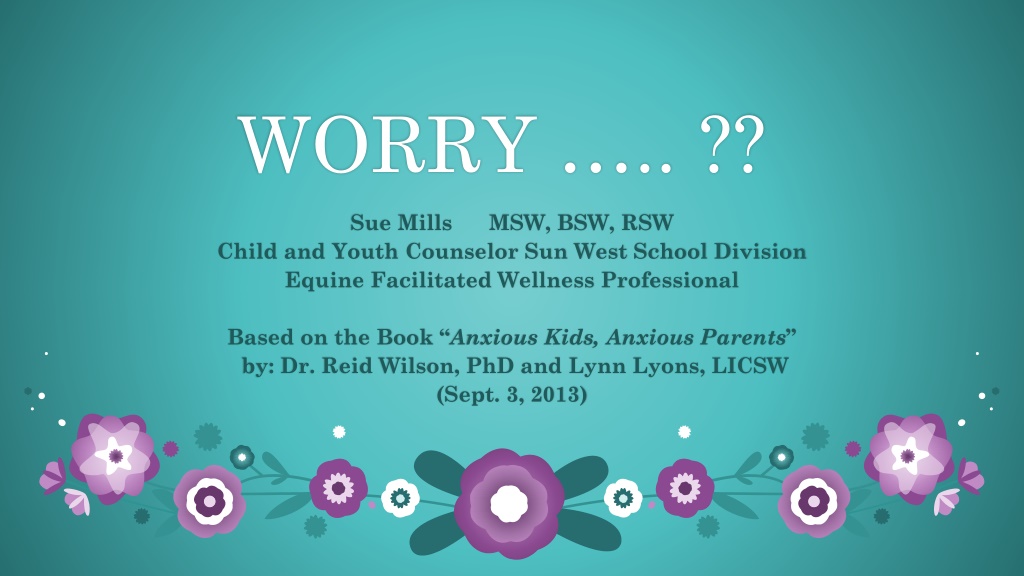
 undefined
undefined






